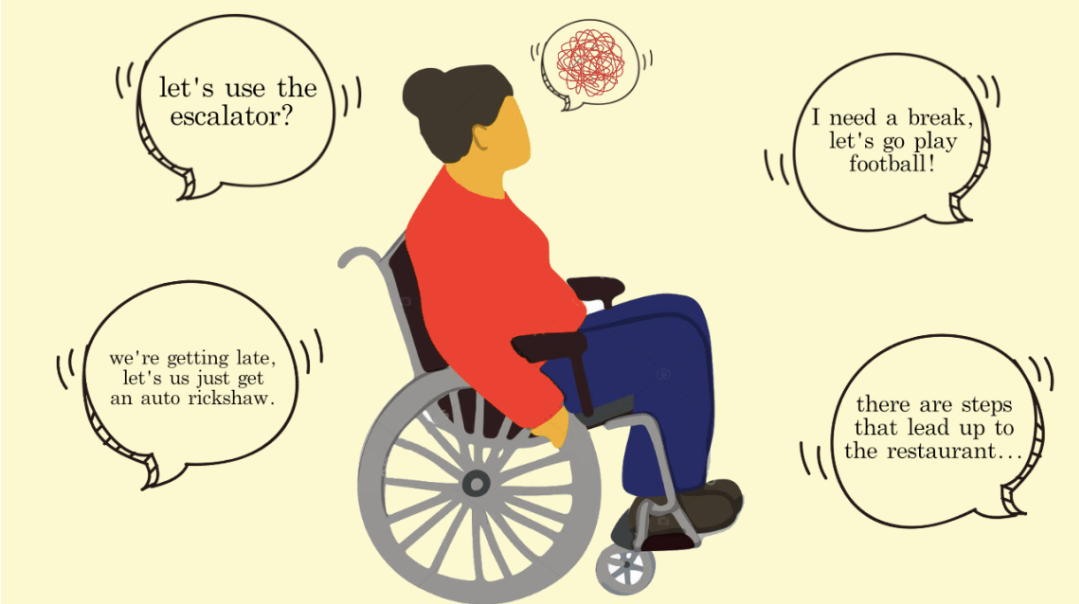This new restaurant in town has been all the rage. You and your friends have booked a reservation a week in advance to eat dinner there. You reach the restaurant, only to realize that it’s on the second floor and the elevator is inoperable. You are wheelchair-bound.
Disabled people of India face a major challenge to gain accessibility to spaces in order to socialise in person, especially when accessibility to social situations is incredibly important for everyone regardless of their ability. The prevalence of disability in India was 2.2% in 2018. That makes it so much more important (and urgent) to create spaces and opportunities for everyone to socialize.
Access to cafes, public parks, movie theaters, malls etc. (and the ability to independently travel to these desired locations) needs to be addressed. This is incredibly difficult in India where our public infrastructure is not designed keeping in mind the diversity in ability. We need ramps in buildings and housing societies that are specifically designed for humans and not cargos and accessible elevators. Transport can be made more disability-friendly by having ramps on buses and trains.
Accessibility to social situations in order to build social ties is needed because it has advantageous effects on our health and well-being. Humans have a social brain which has helped us survive. Socialisation from eons has protected us from impending danger. There is a higher risk of mortality and poor health if there is an absence of close social relationships; this absence might be a consequence of accessibility.
Mental health is related to favorable socialization too. Better mental health is related to fulfilling relationships and interactions. Individuals with disability may have lesser opportunities for favorable socialization, thus probably having an impact on their mental health. Although the digital world might provide us access to fulfilling social relationships, the advantages of in-person contact have to be considered. In-person contact releases a whole cocktail of neurotransmitters, to the point that simply shaking hands or high fiving someone trusted can lower our stress levels. Socialization is motivating; a tool for happiness, a source of resilience and social context also determines formation of healthy habits.
Often children and adolescents with physical disabilities are overlooked or excluded when school physical activities are conducted. These activities are fun and engaging and are scenes for play and socialization. Schools need to make classrooms and sports more engaging for all children and think of new ideas that they can facilitate with inclusion: for example, allowing children with disabilities to play in a wheelchair.
Socialization has crucial consequences for an organization's development too. Supervisors and coworkers are considered to greatly influence integration of people with disabilities. It shouldn’t be a token system wherein the person with disability just got hired for representation, in order to provide adequate support, there should be a team of individuals with disabilities – who can support and share with each other.
Accessibility to social situations is paramount to our mental and physical well-being and has a lasting impact on us, thus it’s only just to ensure that everyone has the means to benefit from the advantages of socialization.
References:
Berkman LF, Kawachi I, Glymour MM. Social Epidemiology. 2nd ed. Oxford, UK: Oxford University Press; 2014.
Government of India Ministry of Statistics and Programme Implementation National Statistical Office. (July – December 2018). Persons with Disabilities in India NSS 76th round.
Holt-Lunstad J, Smith TB, Layton JB. Social relationships and mortality risk: a meta-analytic review. PLoS Med. 2010;7(7)
Kulkarni, Mukta & Lengnick-Hall, Mark. (2011). Socialization of people with disabilities in the workplace. Human Resource Management. 50. 521 – 540. 10.1002/hrm.20436.
Tough, H., Siegrist, J. & Fekete, C. Social relationships, mental health and wellbeing in physical disability: a systematic review. BMC Public Health 17, 414 (2017). https://doi.org/10.1186/s12889-017-4308-6
Meet The Author








